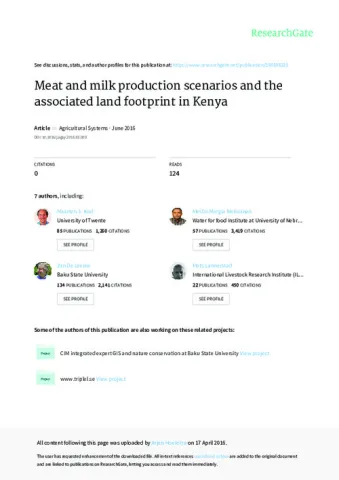Meat and milk production scenarios and the associated land footprint in Kenya

Abstract
Increasing demands for meat andmilk in developing countries and the associated production growth are driving the
expansion of agriculture at the expense of environmental conservation and other land uses. While considerable
attention has been directed at improving crop yields to alleviate the pressure on land, there has been far less
attention on the implications of the expected intensification of livestock production. Here, we present and analyse
the land availability and land footprints of livestock intensification for five scenarios representing various degrees
of intensification of meat and milk production by cattle, sheep, goats and camels in arid, semi-arid and humid
production systems in Kenya. The first three scenarios are defined by increasing levels of input and management,
ranging from low (scenario S1), intermediate (S2) to high (S3) input feed crop cultivation and livestock production.
Reference scenario S1 has production practices and output ofmeat andmilk similar to current production practices.
In scenarios S2 and S3, the total land used for livestock production remains the same as in S1. Two additional
scenarios, S4 and S5, explore opportunities for lessening environmental pressure through reduction of the
land footprint of meat and milk production. For each scenario, we quantify the potential availability of
grassland and cropland for meat and milk production by cattle, sheep, goats and camel in the arid, semi-arid and
humid production systems. A resource use indicator, land footprint (ha), is used to assess changes in land use
associated with livestock production.We estimate that the potential increase in production due to intensification
from scenario S1 to S2 is 51% for milk and 71% formeat. The potential increase due to improving production from scenario
S1 to S3 is 80% formilk and 113% for meat. The area of grazing land, as a percentage of the total potentially available
grazing land, decreases from 10% to 6% as productivity increases from scenario S1 to S5. Cropland usage increases
from 4% in scenario S1 to 11% in scenario S5. Reduced land demand in scenarios S4 and S5 indicates the possibility that
intensification may help reduce the pressure on land and hence promote environmental conservation. Overall, the
results suggest that it is possible to increase production to meet increasing demands for meat and milk while also
gaining land for environmental conservation through intensification. Realizing the potential presented by the intensification
scenarios will be contingent upon successfully establishing and operationalizing enabling policies,
institutional arrangements and markets and ensuring that relevant information, services, inputs, and other essential
requirements are available, accessible and affordable to herders and farmers
